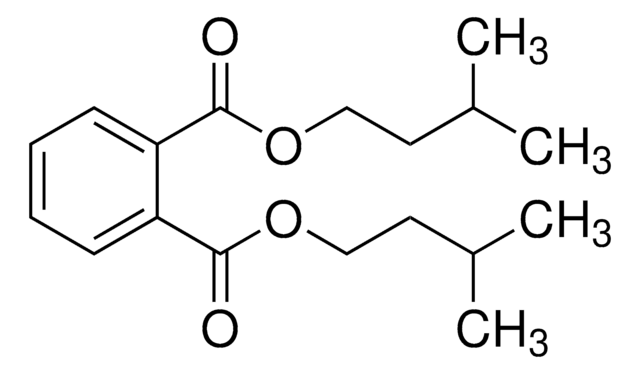36934
Bis(methylglycol) phthalate
analytical standard
Sinônimo(s):
Bis(2-methoxyethyl) phthalate, Dimethylglycol phthalate
About This Item
Produtos recomendados
grau
analytical standard
Nível de qualidade
prazo de validade
limited shelf life, expiry date on the label
técnica(s)
HPLC: suitable
gas chromatography (GC): suitable
pb
230 °C/10 mmHg (lit.)
densidade
1.173 g/mL at 20 °C (lit.)
aplicação(ões)
cleaning products
cosmetics
environmental
food and beverages
personal care
formato
neat
cadeia de caracteres SMILES
COCCOC(=O)c1ccccc1C(=O)OCCOC
InChI
1S/C14H18O6/c1-17-7-9-19-13(15)11-5-3-4-6-12(11)14(16)20-10-8-18-2/h3-6H,7-10H2,1-2H3
chave InChI
HSUIVCLOAAJSRE-UHFFFAOYSA-N
Procurando produtos similares? Visita Guia de comparação de produtos
Categorias relacionadas
Descrição geral
Aplicação
Produtos recomendados
Palavra indicadora
Danger
Frases de perigo
Declarações de precaução
Classificações de perigo
Repr. 1B
Código de classe de armazenamento
6.1C - Combustible acute toxic Cat.3 / toxic compounds or compounds which causing chronic effects
Classe de risco de água (WGK)
WGK 1
Ponto de fulgor (°F)
249.8 °F - closed cup
Ponto de fulgor (°C)
121 °C - closed cup
Equipamento de proteção individual
Eyeshields, Gloves, type ABEK (EN14387) respirator filter
Choose from one of the most recent versions:
Já possui este produto?
Encontre a documentação dos produtos que você adquiriu recentemente na biblioteca de documentos.
Os clientes também visualizaram
Nossa equipe de cientistas tem experiência em todas as áreas de pesquisa, incluindo Life Sciences, ciência de materiais, síntese química, cromatografia, química analítica e muitas outras.
Entre em contato com a assistência técnica








